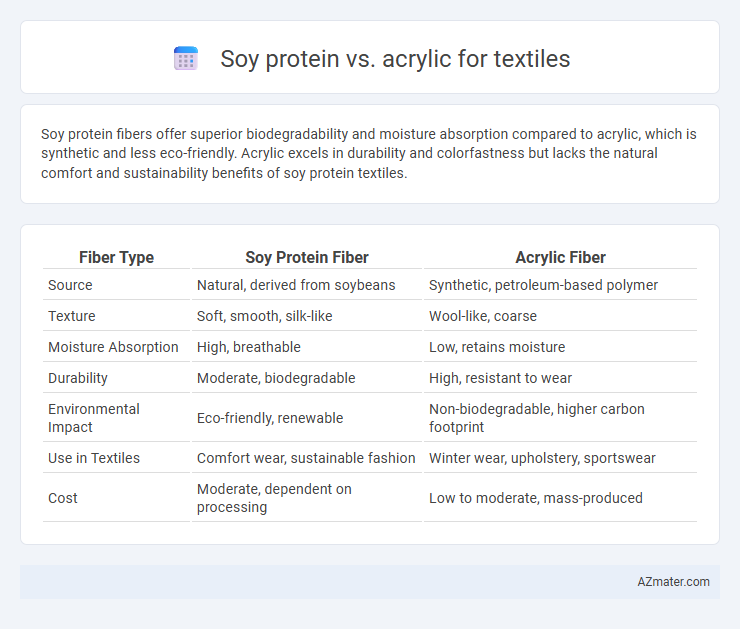Soy protein fibers offer superior biodegradability and moisture absorption compared to acrylic, which is synthetic and less eco-friendly. Acrylic excels in durability and colorfastness but lacks the natural comfort and sustainability benefits of soy protein textiles.
Table of Comparison
| Fiber Type | Soy Protein Fiber | Acrylic Fiber |
|---|---|---|
| Source | Natural, derived from soybeans | Synthetic, petroleum-based polymer |
| Texture | Soft, smooth, silk-like | Wool-like, coarse |
| Moisture Absorption | High, breathable | Low, retains moisture |
| Durability | Moderate, biodegradable | High, resistant to wear |
| Environmental Impact | Eco-friendly, renewable | Non-biodegradable, higher carbon footprint |
| Use in Textiles | Comfort wear, sustainable fashion | Winter wear, upholstery, sportswear |
| Cost | Moderate, dependent on processing | Low to moderate, mass-produced |
Introduction to Soy Protein and Acrylic in Textiles
Soy protein fibers, derived from soybean meal, offer a sustainable and biodegradable alternative in textile production with natural moisture-wicking and softness properties. Acrylic fibers, made from polyacrylonitrile polymer, provide durability, vibrant color retention, and resistance to mildew and chemicals, commonly mimicking wool textiles. The contrasting attributes of soy protein's eco-friendliness and acrylic's synthetic resilience highlight their distinctive roles in modern fabric applications.
Origins and Production Processes
Soy protein fibers originate from defatted soy flour, derived from soybeans through a process involving extraction, drying, and spinning into natural fibers known for biodegradability and moisture absorption. Acrylic fibers are produced from synthetic polymers, primarily polyacrylonitrile, through a chemical polymerization process followed by solution spinning and stretching to create durable, lightweight fibers with excellent colorfastness. The production of soy protein fibers emphasizes renewable agricultural resources and eco-friendly techniques, contrasting with acrylic's petrochemical origins and energy-intensive manufacturing.
Environmental Impact Comparison
Soy protein fibers exhibit superior environmental benefits compared to acrylic in textile production due to their renewable, biodegradable nature and lower carbon footprint. Acrylic fibers, derived from non-renewable petroleum, contribute to higher greenhouse gas emissions and microplastic pollution during washing. The lifecycle assessment of soy protein-based textiles demonstrates reduced water consumption and energy use, supporting more sustainable fashion industry practices.
Physical and Mechanical Properties
Soy protein fibers exhibit excellent moisture absorption and biodegradability, making them environmentally friendly but generally less durable than synthetic fibers. Acrylic fibers demonstrate high tensile strength, excellent elasticity, and resistance to abrasion, making them suitable for applications requiring durability and resilience. The physical softness of soy protein contrasts with the synthetic nature of acrylic, which offers superior mechanical performance in textiles needing long-term wear resistance.
Comfort and Breathability
Soy protein fibers offer superior comfort and breathability compared to acrylic, as their natural composition allows for better moisture absorption and air permeability, reducing skin irritation and overheating. Acrylic fibers, being synthetic, tend to trap heat and moisture, leading to less breathability and a heavier feel against the skin. Choosing soy protein textiles enhances wearer comfort by promoting airflow and maintaining a cooler, drier environment.
Durability and Wear Resistance
Soy protein fibers exhibit moderate durability and wear resistance, making them suitable for lightweight and delicate textile applications, but they tend to degrade faster under abrasion and frequent washing compared to acrylic fibers. Acrylic fibers offer superior durability and excellent wear resistance due to their synthetic polymer structure, which maintains tensile strength and shape retention over prolonged use and repeated laundering. Textile manufacturers often prefer acrylic for high-performance garments and upholstery where long-lasting wear and resistance to pilling are critical.
Dyeability and Aesthetic Qualities
Soy protein fibers exhibit superior dyeability compared to acrylic, absorbing a wider range of dyes with richer, more vibrant colors and better colorfastness due to their natural amino acid structure. Acrylic fibers, being synthetic, often require specific dye types such as cationic dyes and typically yield less saturated and uniform colors, impacting aesthetic appeal. The natural texture of soy protein enhances fabric softness and sheen, contributing to a more luxurious and matte finish, while acrylic fibers tend to produce shinier, less breathable textiles with a synthetic feel.
Cost and Market Availability
Soy protein fibers are emerging as eco-friendly alternatives in textiles, with moderate production costs but limited large-scale market availability compared to synthetic options. Acrylic fibers offer widespread market availability and lower production costs due to established manufacturing processes and economies of scale. The higher cost and niche market presence of soy protein textiles currently limit their competitiveness against the extensively produced and cost-efficient acrylic fibers.
Applications in Modern Textiles
Soy protein fibers offer excellent biodegradability and moisture absorption, making them ideal for eco-friendly and comfort-oriented textile applications such as activewear and casual clothing. Acrylic fibers provide superior durability, colorfastness, and resistance to UV rays, widely used in upholstery, outdoor fabrics, and winter apparel. Modern textiles increasingly blend soy protein with synthetic fibers like acrylic to enhance sustainability without compromising performance or longevity.
Future Trends and Sustainability Potential
Soy protein fibers offer biodegradable and renewable advantages over acrylic, which is synthetic and petroleum-based, contributing to environmental concerns. Future trends indicate increasing adoption of soy protein textiles due to their lower carbon footprint, enhanced biodegradability, and compatibility with circular economy models. Innovations in soy protein fiber technology are improving durability and comfort, positioning it as a sustainable alternative in the textile industry seeking eco-friendly materials.

Infographic: Soy protein vs Acrylic for Textile
 azmater.com
azmater.com